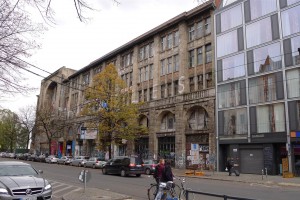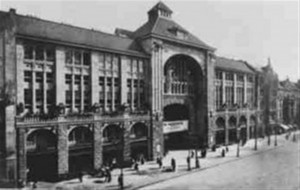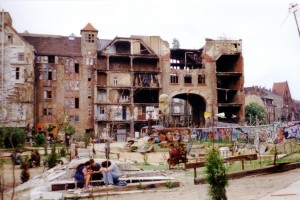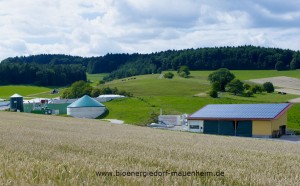In a recent New York Times article about the changing face of Brooklyn, A.O. Scott writes “Every city is simultaneously a seedbed of novelty and a hothouse of nostalgia, and modern New York presents a daily dialectic of progress and loss.”
The same could be said of Berlin.

Tacheles today
Some weeks ago I came across a building called Tacheles that I had not seen in fifteen years. It was more like the shell of a building, although that was already an apt description when I first saw it in January of 1998. Back then I was visiting Germany — and Annette — for the first time. Since Annette was working during the day, I spent much of that visit biking around the city and looking at buildings.
Berlin was rougher back then, more of a work in progress. Numerous tower cranes punctuated the skyline like so many erector sets. Postdamer Platz was a huge hole in the ground. The latest proposal for the Memorial to the Murdered Jews of Europe was being hotly critiqued. And although the Berlin Wall had been down for nearly ten years, the differences between East and West Berlin were still evident. The majority of the drab GDR-era buildings in East Berlin had not yet been renovated (the German word is saniert, which has the same Latin root as “sanitized”). I marveled at the pockmarked stone exteriors of many buildings in the East. The East German government apparently had more pressing concerns than patching holes left by bullets and shrapnel from World War II.

Tacheles department store

Tacheles circa 1996
One evening during that first visit to Berlin, Annette took me to Tacheles. If she was trying to impress me, it worked. Before World War II, Tacheles had been a department store in the city’s Jewish quarter. The building was damaged during the war, and never repaired. Portions of the structure were demolished in 1980, and the rest was scheduled to be taken down in 1990, but a group of artists staged a protest that eventually led to the building being granted historic landmark status. When Annette and I were there in 1998, Tacheles was a graffiti-tagged warren that included artists’ ateliers, funky places to eat and drink, and a small movie theater. Music and smoke hung in the air. Because sections of the rear wall of the building were missing, one could see into some of the rooms from the sculpture garden behind the building. The menu at the restaurant where we ate was printed on an Eviction Notice for the building’s occupants.
Seeing Tacheles recently brought back memories of what Berlin was like in 1998, of who I was — a young man falling in love — and of who Annette and I were — a couple embarking on a shared life. Berlin has changed, as have we.
Continue reading →




